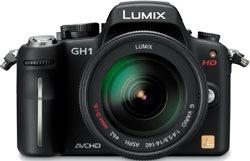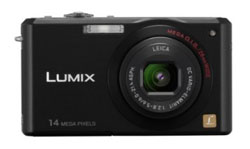 Panasonic Lumix DMC-GH1
Panasonic Lumix DMC-GH1Panasonic has today announced a new Micro Four-Thirds camera with high-definition video capability. The camera is called Panasonic Lumix DMC-GH1 and also sports a new 14 (12.1 effective) megapixel sensor. The video function seems to be very advanced as it lets you auto focus while recording and functions such as face detection and image stabilization.
Some key features for the Panasonic Lumix DMC-GH1:
-14 megapixel sensor
-high-definition video capability (1080i or 720p)
-built-in Dolby Digital Stereo Creator
-face detection
-four different aspect ratios
Press release:
PANASONIC CONTINUES ITS DIGITAL PHOTOGRAPHY REVOLUTION WITH THE ADDITION OF THE LUMIX GH1 – ITS NEW MICRO FOUR THIRDS DIGITAL CAMERA WITH HD RECORDING CAPABILITY
The Panasonic LUMIX DMC-GH1, a Creative HD Hybrid, Offers Professional-Level Still Photos and HD Video Performance Yet is Easy Enough for Entry-Level DSLR Consumers
Las Vegas, NV (March 3, 2009) – Panasonic today introduced the DMC-GH1, the newest member of the company’s revolutionary LUMIX G Micro System – a new digital interchangeable lens camera system that delivers professional-level features and performance in a compact and easy-to-use camera body.
Compatible with the Micro Four Thirds System standard, the new LUMIX GH1 features advanced video photography functions, such as the ability to record High Definition (HD) AVCHD 1080p/24p video.* In addition, the new LUMIX GH1 comes with a newly developed long-zoom interchangeable lens – the LUMIX G VARIO HD 14-140mm/F4.0-5.8 ASPH./MEGA O.I.S. This lens was specifically designed to support HD movie recording and features a silent motor and continuous auto focusing (AF) capability; two features which distinguish the LUMIX GH1 from DSLRs that offer HD video recording capabilities.
“Photographers of all levels – professionals, amateurs and beginners – will be stunned by the range of creative possibilities that the LUMIX GH1 creates in the world of high-quality photography and HD video. Users will be equally amazed by the camera’s easy-to-use design and small size,” said David Briganti, National Marketing Manager, Imaging, Panasonic Consumer Electronics Company. “Beyond its creative potential, the LUMIX GH1, a sister product to the award-winning LUMIX G1, is also innovative and differentiates itself from the pack by recording High Definition video with continuous AF, an indispensable feature for practical video recording.”
In late 2008, Panasonic redefined the traditional DSLR category with its launch of the Panasonic LUMIX G1 – a digital, interchangeable lens camera system that takes the radical step of eliminating the large, internal mirror structure that is currently contained in all traditional DSLR cameras. This innovation allows for dramatically smaller camera body and lens sizes and permits many new, advanced consumer features such as LUMIX G1 “Live View Finder”. With its 2008 launch, the LUMIX G1 achieved several honors, including:
*
World’s first entry into the Micro Four Thirds Standard system camera segment
*
World’s first interchangeable lens camera to offer colored body options to consumers
*
Winner, 2008 Camera of the Year (Popular Photography & Imaging magazine)
The new LUMIX GH1 provides cutting-edge video recording features, including the ability to record high-resolution full HD (1920 x 1080) video at 24 fps or smooth HD video (1280 x 720) movie at 60 fps using an AVCHD format (MPEG-4/H.264). The AVCHD format provides the important benefit of doubling the HD quality recording time compared with Motion JPEG. The LUMIX GH1 hosts a dedicated video record button on the back of the camera which lets users instantly start recording videos, even while shooting still photos – removing the fear of potentially missing a must-see video moment. The LUMIX GH1 also records video in high-quality stereo sound via Dolby Digital Stereo Creator, the global standard of audio recording. An optional stereo microphone (DMW-MS1) is also available to achieve a more intensive sound recording experience. Finally, a convenient Wind Cut function is provided to help to block out distracting video background noise.
Like the LUMIX G1, the LUMIX GH1 features the Live View Finder system which enables something that simply is not possible with conventional DSLR cameras – the ability to preview the effects of camera settings (e.g., exposure, aperture, shutter speed) before taking the photo. This helps take the guesswork out of the camera setting process and helps users ensure that every photo they capture comes out exactly as they envisioned.
The brilliant 1,440,000-dot equivalent Live View Finder system can also display information settings that a user can see without removing their eyes from the subject. Furthermore, a built-in eye sensor automatically switches on the viewfinder when the user looks into it, then switches it off and turns on the swivel 3.0-inch large 460,000-dot high-resolution LCD when the user looks away from the viewfinder. The 60-frames-per-second Live View is made possible by the Live MOS sensor, which takes real-time signals directly from the image sensor and sends them continuously to the LCD. Both the Live View Finder and LCD provide a 100% field of view – allowing the user to accurately frame and compose a shot from most any position.
The LUMIX GH1 kit lens – the LUMIX G VARIO HD 14-140mm/F4.0-5.8 ASPH./MEGA O.I.S. –provides a broad focal length range of 28-280mm (35mm camera equivalent) and supports continuous AF using the contrast AF system for both photo and movie capture. The low-noise lens design also seamlessly supports video recording by minimizing the mechanical sound generated by AF/AE actions.
At the core of the LUMIX GH1 lies a newly developed 12.1-megapixel high speed Live MOS sensor and Venus Engine HD, which features twin CPUs for outstanding processing capabilities. The Live MOS sensor is capable of high-speed readout over four channels to be compatible with full-HD movie recording. This sensor is also advantageous for photo recording with a high signal-to-noise ratio thanks to the new circuit structure that is unaffected by the noise generated in each of the circuits. This results in crisp photos – even those taken at high ISO levels. The multi-aspect type sensor allows users to take photos in 4:3, 3:2 or 16:9 aspect ratios with the same angle of view. The Venus Engine HD is also energy efficient, supporting long periods of AVCHD video recording on a single battery charge.
In addition to the digital camera’s HD video recording capability, the DMC-GH1 features the LUMIX Creative Movie mode which lets the user manually set the shutter speed and aperture, making their videos more creative and representative of their own personal video style preference. Changing the shutter speed gives the videos a special look, particularly suitable for shooting fast-moving subjects. Controlling the aperture is convenient when there are several subjects at varying distances, so the user can focus on the foreground and blur the background – or vice versa.
While the LUMIX DMC-GH1 has cutting-edge still image and video capture features, the LUMIX GH1 is also incredibly easy-to-use, thanks to Panasonic’s iA (Intelligent Auto) mode** – a user-friendly setting made popular in the LUMIX line of digital point-and-shoot camera products. Panasonic’s iA mode is a suite of technologies which engage automatically (no settings needed). The latest addition to the iA suite of features is Face Recognition, a feature that directs the camera to prioritize focus and exposure on a specific face that that the user had previously registered in the camera.*** This invaluable function makes it especially easy to take sharp and beautifully exposed images of things the user values most in their photos – the user’s friends and family.
Panasonic’s iA mode offers other innovative features which help deliver consistently outstanding photos: O.I.S. (Optical Image Stabilization) to help reduce blurring from hand-shake; Intelligent ISO Control to help limit motion blur by adjusting the ISO sensitivity if the subject moves as the shot is taken; AF Tracking that lets the camera lock onto any subject and keep it in focus even if it moves; Intelligent Exposure which optimizes the exposure for each part of an image, preventing blocked shadows and blown highlights, and helps ensure that gradation and details are reproduced beautifully; and Intelligent Scene Selector which automatically detects the five most common shooting situations – Portrait, Night Portrait, Scenery, Night Scenery and Close-up – and switches to the appropriate Scene mode.
Best of all, the benefits of Panasonic’s iA mode extend to motion image recording on the DMC-GH1. For example, the LUMIX GH1 motion iA includes O.I.S. and Face Detection, which automatically detects a face in the frame and adjusts focus, exposure, contrast, and skin complexion. Intelligent Exposure continually checks the ambient light level and adjusts the exposure setting as conditions change to prevent blown highlights and blocked shadows. Intelligent Scene Selector automatically switches between Normal, Portrait, Close-up, Scenery, and Low Light modes according to the environment.
The Contrast AF system adopted by the LUMIX GH1 is accurate, easy-to-use and fast. Users can choose from a wide range of AF modes, including multiple-area AF with up to 23 focus areas, 1-area AF with a selectable focus area, Face Detection, and AF Tracking. To help keep the images free of spots from dust and particles, the Supersonic Wave Filter dust reduction system helps prevent foreign contaminants from adhering to the image sensor.
After users capture their images using the LUMIX GH1, it’s easy for them to enjoy their photos or HD videos immediately on a large-screen Panasonic VIERA® high-definition television. All that is required is to remove the SD Memory Card from the LUMIX GH1 and insert it into the VIERA Image Viewer (SDHC/SD Memory Card slot) located in the VIERA HDTV or in the Panasonic Blu-ray disc player. Alternatively, an optional mini HDMI™ cable is available to output the images from the LUMIX GH1 directly to the Panasonic HDTV via VIERA Link™. Then, using the VIERA HDTV’s remote control, users can take advantage of the LUMIX GH1’s advanced playback and slideshow features.
In addition to the new LUMIX G lenses, the DMC-GH1 and LUMIX G Micro System is compatible with any interchangeable lens that complies with the Four Thirds standard.**** This gives users access to the entire range of Four Thirds lenses. Additional Micro Four Thirds lenses will be announced in the future, giving users a large, diverse line of high-performance lenses to add to their photographic toolboxes. With the LUMIX G Micro System and the growing assortment of lenses becoming available, the creative possibilities are endless.
The LUMIX DMC-GH1 is a system camera with a wide variety of options to choose from to match a wide range of shooting situations and styles. Accessories compatible with the LUMIX G Micro System include: External Flash: DMW-FL220(GN22) / DMW-FL360(GN36) / DMW-FL500(GN50); PL Filter: DMW-LPL62; ND Filter: DMW-LND62 (New); MC Protector: DMW-LMCH62; Mount Adapter: DMW-MA1; Stereo Microphone: DMW-MS1 (New); Battery Pack: DMW-BLB13; DC Cable: DMW-DCC3; Soft Cases: DMW-CG1, DMW-CG2 (New); Soft Bag: DMW-BAG1; Shoulder Strap (Stylish) DMW-SSTG1-A/C/R/K(New); Shoulder Strap (Woven) DMW-SSTG2-W; Shoulder Strap (Leather) DMW-SSTG3-T; Remote Shutter: DMW-RSL1.
For more information about the DMC-GH1 and all of Panasonic’s LUMIX G Micro System accessories, please visit www.panasonic.com/lumix.
*Full-HD (1920 × 1080) movies are output by the image sensor at 24p (NTSC)/25p (PAL), and recorded at 60i (NTSC)/50i (PAL). HD (1280 × 720) video is output and recorded by the image sensor at 60p (NTSC)/50p (PAL).
** Some functions in iA mode will not be available depending on the lens to attach.
***Turn Face Recognition item ON and register the person with full-face portrait on the shooting menu in advance. Recognition performance varies greatly depending on shooting conditions, i.e., according to factors such as angles, facial expression and lighting, so operation under all conditions cannot be guaranteed. Because the camera searches for faces that are similar to registered faces, there are cases where the faces are not correctly recognized when the registered image and the shooting image varies greatly. When facial characteristics are similar, particularly between parents and their children or brothers and sisters, the camera may not distinguish the faces.
****Some functions on DMC-GH1 are not available depending on the lens that is attached




